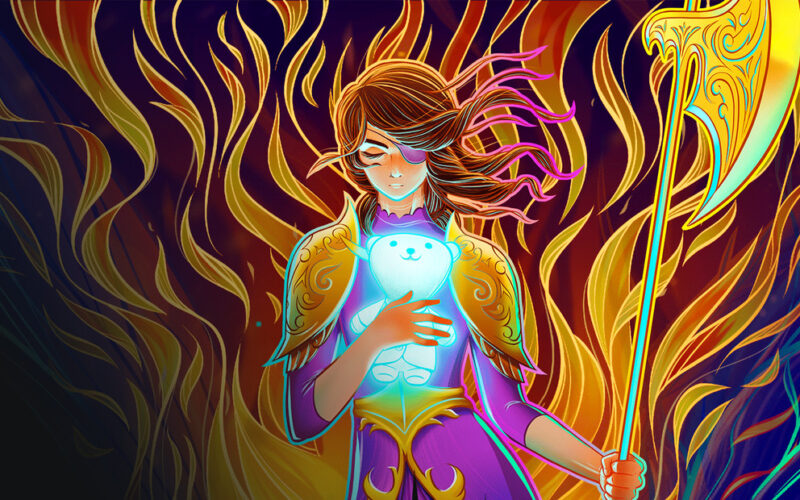It’s been said before that we are in a golden age of Metroidvanias. Where we once had few representatives of the genre, now we have them in every style conceivable. All thanks to the rise of Indie studios that have managed to take a beloved genre and infuse it with new and original ideas, while also bringing modern design into the mix. And yet, I don’t believe this “golden age” is a product of quantity in the genre, but rather quality.
What makes this a great time for Metroidvanias is that we’ve built on top of the successes of the games that came before. We saw the good and the bad and learned from them. We expanded upon those lessons and created new games that are orders of magnitude greater than its predecessors. And in this landscape of experience and inspiration, Halberd Studios came into the mix and showed that it paid attention in class and applied those lessons to 9 Years of Shadows.
Developer: Halberd Studios
Publisher: Freedom Games
Platform: PC
Release date: Mar 27, 2023
Price: $19.99
9 Years of Shadows is a side-scrolling Metroidvania that features a very interesting armor system and beautiful pixel art. You take the role of Europa in her quest to save the world from the corruption that has stripped the land of its colors.
Into the twisted depths of Talos
Right out of the gate, 9 Years of Shadows comes out swinging with its beautiful intro. Rather than swarm you with a wall of text about its story, the game just sends you out into Talos to experience the decadent state of the world first hand. Stripped of colors, the corridors of Talos feel unnerving and hostile towards you. There is an eerie atmosphere that evokes the intro sequence of Super Metroid (both the Ceres intro and the Zebes intro). You are definitely not welcome.
But other than convey its atmosphere, the intro also shows you the core mechanics and exploration of the game with the cleverness of old games. Rather than displaying lengthy tutorials, instead 9 Years of Shadows eases you into the exploration aspects in a more organic matter. For example, there is a hidden wall hidden behind a destructible object. As a player, you know you want to hit the object and in the process end up discovering, by yourself, that walls can be destroyed.
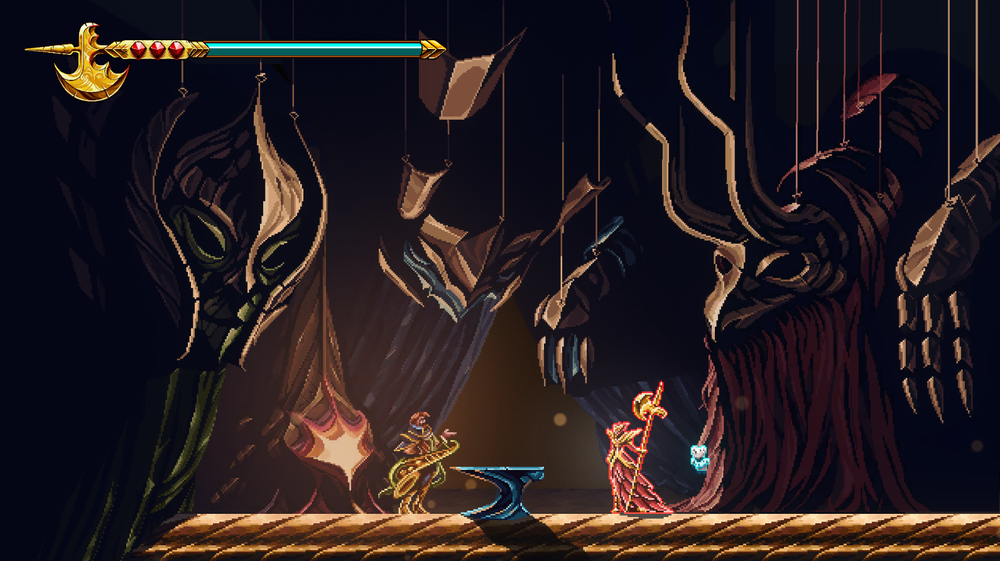
There’s also distant displays of the kind of traversal you will see further into the game, like a lake where you will clearly have the ability to dive in the future or the snake tunnels. Teasing of what’s to come and greasing the gears in your mind of how you can explore this world.
Get equipped
The core element to the exploration in 9 Years of Shadows are the elemental armors you will find throughout your journey. These armors take the role of progression items, which will allow you to backtrack unexplored locations while also featuring some neat sequences on their own.
On their most basic level, the armors will work as keys to open locks in the world, with each lock matching the color of the armor. However, the real beauty of the armors comes from the follow-up abilities that are unlocked afterwards. These new abilities offer ways of moving that are completely different from what you’ve been used to.
For example, the mermaid form allows you to swim, but also creates stages similar to Ecco the Dolphin where you must take advantage of your speed to make big jumps and clear the gaps.
A blessing and a curse
Armor Switching can be done my pressing L or R to cycle through them like weapons in a different game, but there’s a better way of transforming. Simply by touching the element relevant to its armor you will be automatically switched to the corresponding form. Touching water will switch you to Poseidon form, for example. This also enables some of the later levels to feature intricate combinations of stage layouts that feel great to traverse thanks to the game handling the switches for you.
However, what I really liked was how the quick switching was used to hinder the player in some instances. While it might be advantageous to use the armor of water to hit a blue switch, you might be thrown a curve ball and be hit by a poison environment that will switch to the earth armor and disable your ability to hit the switch unless you rid the poison from the room.

And this also applies to combat, where the map might force you into a disadvantaged armor to make an encounter tougher. Knowing how to fight, but also how to position yourself is they key to making the most of your armor.
My one complaint in this regard is that, while the different forms of navigation are cool, I feel like they overcomplicate backtracking later in the game, especially the snake tunnels that don’t show on the map and can feel a little confusing given that they extend pass the viewable screen size. Not only that, but also the quick switching removes the freedom of exploring the map wearing your favorite armor,
Attack and Defense
When it comes to combat, 9 Years of Shadows keeps it on the simpler side. Your combat is a mixture of light attacks, heavy attacks, jumping and back dashing. The combat is basic and easy to understand, but it might have ended being too basic for its own good. Light and heavy attacks can’t be combined to create combos, but rather heavy attacks are only used as finishers.
Strategy comes from the way of the outlines on the enemies. Enemies can have one of 5 different outlines that correspond to the 4 armors and magic. Matching your armor with the enemy outline will allow you to deal extra damage. It will also allow you to bypass certain shields to damage enemies. The outlines only make enemies weaker to an element, not stronger to others, so you won’t run into a situation where you deal less damage.

While I like the weakness system on paper, I didn’t find it too fun during my play through. Since it’s just a straight up damage boost, I didn’t feel like it expanded the game beyond “press R until you find the correct color”. Perhaps it might have felt better if there was a more intuitive way of switching armors, like opening a radial menu and quickly tapping the direction of the armor you choose.
I also don’t understand why some impossible outlines exist in the game, like having a red outline on a water section where the water can’t be removed.
Element of Pain
What I feel that hurts 9 Years of Shadows the most is how shallow the combat feels after an hour or so. While simple combat controls are common in other Metroidvanias, like Symphony of the Night and Hollow Knight, I feel like they offer depth in other areas that isn’t apparent in 9 Years of Shadows.
One of this areas is the “advanced mechanics” present in other games. Back dash cancelling is a pretty common mechanic in many games, one that even has created muscle memory in veterans of the genre. In this game you can cancel light strikes, but you can’t cancel heavy attacks. I understand this might be a conscious design decision to make heavy attacks committal, but I can’t help thinking it might have felt better to just let it slide. Charge attacks can’t be cancelled either, and they feel clunky to use because your charge is cancelled when you take damage, but it doesn’t start over unless you release and press the button again.
The biggest missed opportunity comes from a lack of weapon variety. While the different forms offer different heavy attacks, there isn’t much variety elsewhere. Your attacks fundamentally don’t change, so the combat feels repetitive. Enemies don’t offer much incentive to be killed either. All you get from them is currency, which would be fine if it wasn’t that upgrades are gated by relics, not money. You still need money, but that’s a secondary requirement.
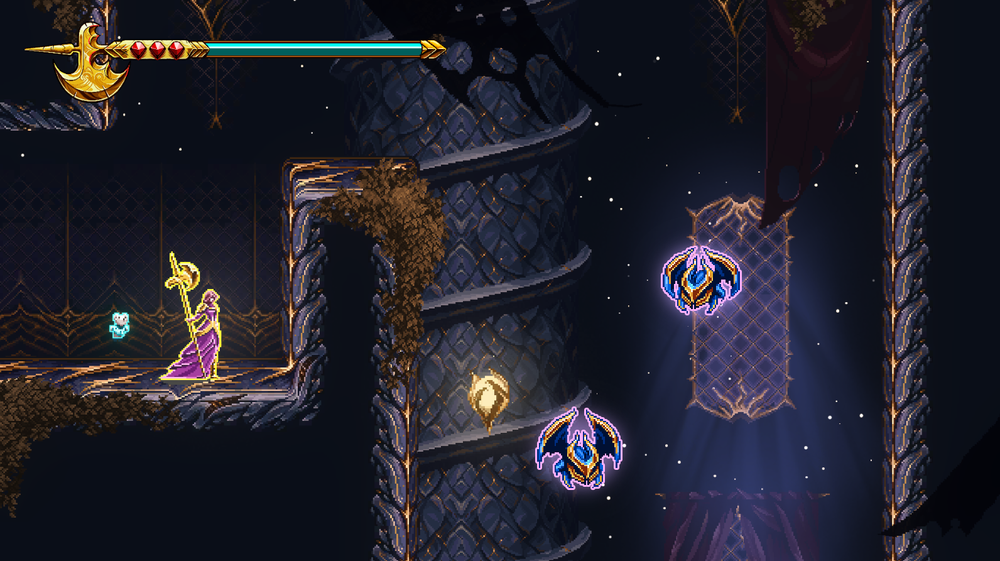
The magic of love
Accompanying you on your journey is a ghostly companion named Apino. Apino functions similar to an option in shmup games. By using the right stick, Apino can fire in the chosen direction. He can also activate switches with abilities that he will acquire throughout the game.
What makes Apino so interesting to the game, is that his attacks are linked to your magic gauge. But rather than magic being just an offensive resource, magic also works as your shield. Getting hit will reduce your magic bar, but so will using Apino to shoot. The result is a risk/reward system where you need to decide whether your resources are better used attacking or defending.
Magic can be recovered by defeating enemies. If your magic is empty, you can hug Apino to recover a portion of your magic gauge, however, you must remain motionless while the animation completes. Similar to Hollow Knight and recovering your masks, hugging Apino is a move that requires awareness of when and where it is safe to recharge.
Gears of Warpino
Eventually, you will learn an ability that I believe makes the risk/reward of magic more advantageous given that you have the skill to make it work. This ability is a kind of “active reload” similar to the one present in Gears of War. When your magic empties for the first time, a gauge will appear on top of your head with a cursor advancing from left to right. Hit the correct spot in the gauge, and you will recover your entire magic gauge without needing to hug Apino or defeat enemies (but hug Apino every now and then because we all need love).

My favorite part about this mechanic is that you can turn great offense into great defense. With a little awareness and coordination, you can recklessly use Apino to attack and then recharge your entire magic to resume your offense. It’s still a gamble, but one that can turn the tables in your favor. Alternatively, if you find yourself low on magic, you can empty it yourself and trigger the active reload to immediately recharge it all. Though the reload mini game becomes harder with each successful use, so don’t abuse it too much.
My only gripe is with how the reload gauge always appears on top of Europa. With how combat has you moving around the screen and then being knocked away by the enemies, it can get a little hard to find your character in time and react to the gauge. I wish the gauge would always appear in a fixed position, but really this is me just being greedy and being used to keeping an eye on meters for fighting games. And the reload is incredibly strong, so I can understand trying to make it more challenging.
Too many uses for so little resources
Where I think the magic gauge and its uses trip upon themselves is with enemies that are only vulnerable to magic. I like the risk/reward of magic when it can be liberally used, but things change when it becomes a requirement. Recharging magic isn’t trivial by any means, so when faced with an enemy that can only be damaged by magic, your options become limited. If you failed the reload, your only choice in most of these scenarios is to hug Apino, which requires you to completely disengage from combat (if you can).
This becomes even worse with boss fights where you can’t run away. The later you get into the game, the more you will encounter bosses that need to be hit my magic to be made vulnerable. Many of them feature aggressive attack patterns that must be avoided before the enemy exposes itself. If you are out of magic, well then I’m sorry but you will have to give your turn to attack in order to recharge, and hope you kept enough magic for the next break.
Break the sequence
I understand the punishment for not dodging enough to be to prevent you from getting some damage on the boss, but I feel like the nuances of magic work against you to prolong fights in a way that’s neither fun nor engaging. This is the point at which many of the previous points converge. Dark Souls taught us the beauty of repeating boss encounters until you get the patters right, but the lack of combat depth in 9 Years of Shadows makes repeating boss fights feel tedious.
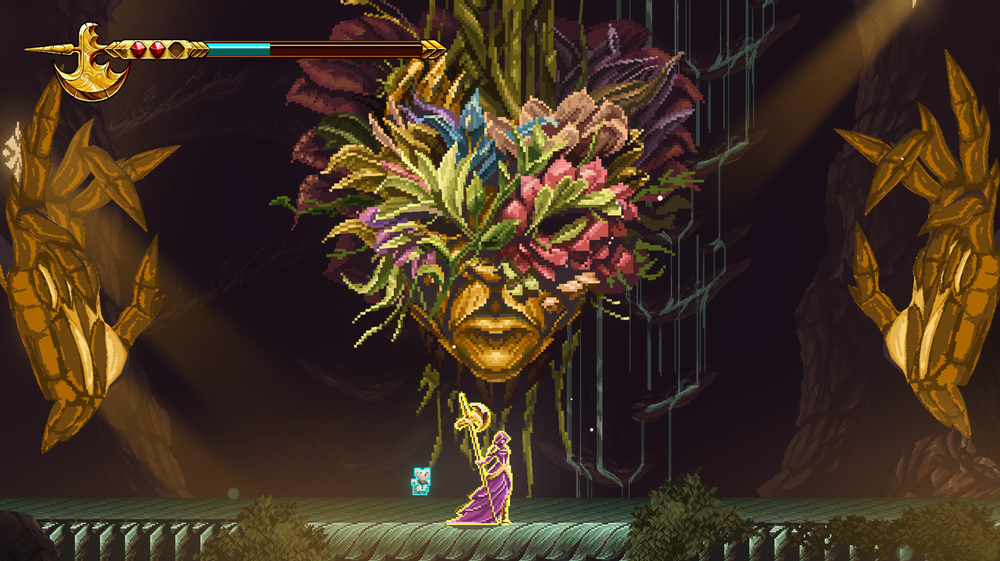
It doesn’t help that late game bosses in 9 Years of Shadows overall just feel cheap. There are boss types that are challenging and engaging, and then there’s bosses just outright trying to kill you. I feel like the contrast is too stark, with the early bosses being very elegant showdowns that require skill and finesse. As opposed to the later encounter when bosses just abuse appearing hurt boxes on screen out of nowhere and teleporting to where you are. It makes me think about how Iga made the developers no-hit every boss on Bloodstained to gain their approval. Perfect fights are doable here, but only by virtue of being painfully slow and careful.
The late game
During the final stretch of 9 Years of Shadows is when I feel like most issues start popping all at once. A lack of enemy variety, combined with a lack of weapons make the combat feel repetitive. Even worse if you maxed out your upgrades, as it completely removes the incentive to fight altogether.
It is at this point where you should feel the most powerful, and yet other than combining movement styles, there’s just not much to show for it. You can’t really overpower enemies because your damage only increases once. You can freely match silhouettes given that terrain isn’t blocking you, but it is just a game of memory pressing L and R to remember where the form you need is.
And then there’s that one thing that happens at the end of the game that completely changes how everything is played. While it adds some cool abilities like Castlevania’s Black Panther dash, it completely changes how everything else plays out. Why change everything right before the final fight? Yeah sure, the moment was cool, but the frustration of hours of muscle memory being stripped away feels awful.
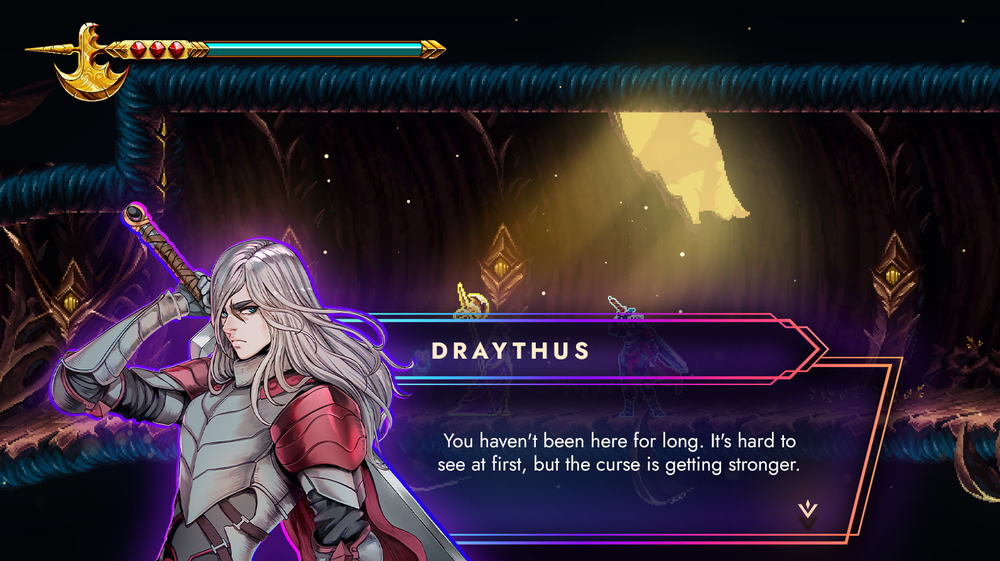
Then for your final backtracking, you start to realize how there’s really no convenient way to fast travel. Even the Panther dash is stopped in its tracks by beefier enemies. Through this final item hunt I was constantly reminded of how much I wanted a pin system on the map. It turns out my final item was in a room that I could enter, but not reach the item because I lacked the fire form. In case you are looking for the same blue relic as I am, it’s in the first Sector in that room with the red current.
Tribute to the classics
Despite all the gripes I had in regards to the gameplay and overall handling of difficulty, I will say that 9 Years of Shadows constantly made me smile with just how many references where included.
The whole Super Metroid inspired intro. The chests reminiscent of Hollow Knight. Bosses turning red like Super Metroid. A “show, don’t tell” tutorial inspired by Mega Man X’s intro stage. The MMX explosion on the bosses at the end. Even the boss that is clearly Death but not really.
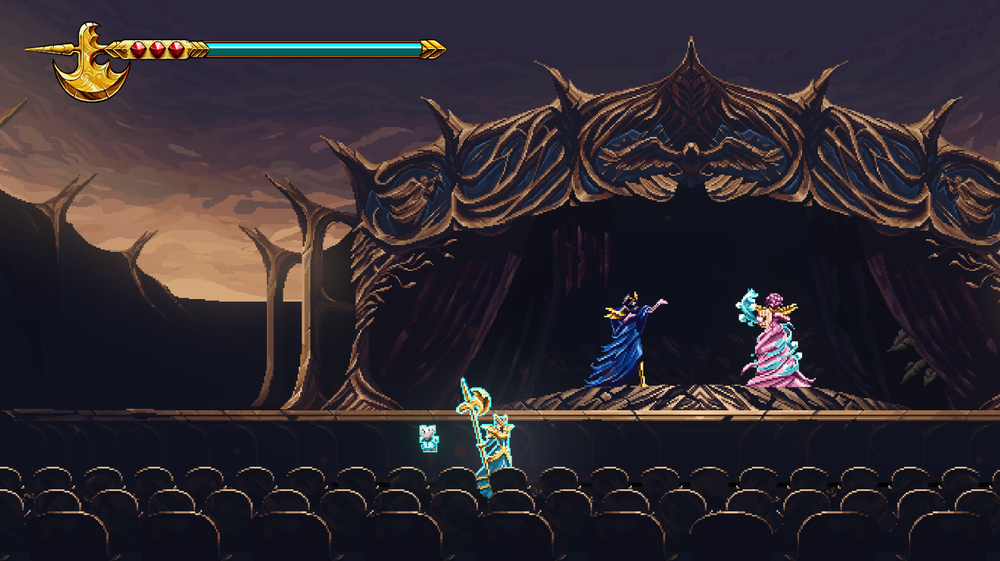
But perhaps my absolute favorite was the handling of the elevator sequences. The very few bits of self-reflexion Europa has are all handled during elevator sequences. This play out like Metroid Fusion, where past events were told during the elevators. Though I do wish there was something different happening when all the possible conversations are exhausted, after all, we still need to use elevators.
Closing thoughts
Despite the unrefined combat, I do feel like 9 Years of Shadows has some very interesting core ideas that just fell flat. There are a myriad of sources of inspiration present, but not all of them were able to properly shine.
It’s unfortunate because I really do think the game has an incredible presentation. And I don’t only mean the pixel art and the animations. I think that the way the game presents itself and its mechanics is very elegant. Late game bosses aside, the rest of the enemies and bosses are engaging to fight and understand. There was a very clear intent put into making their threat palpable while also giving good visual feedback.
I had fun playing 9 Years of Shadows. There’s a blueprint in here for an incredible game, and I hope a sequel can truly realize its potential.
Also, fix the “Fully equipped” achievement!

